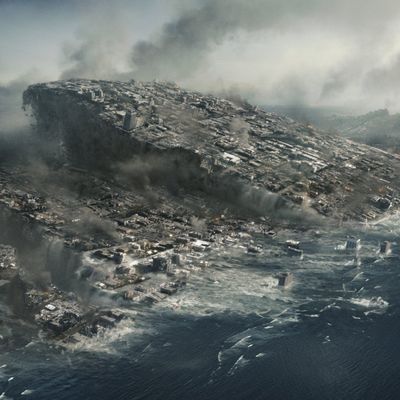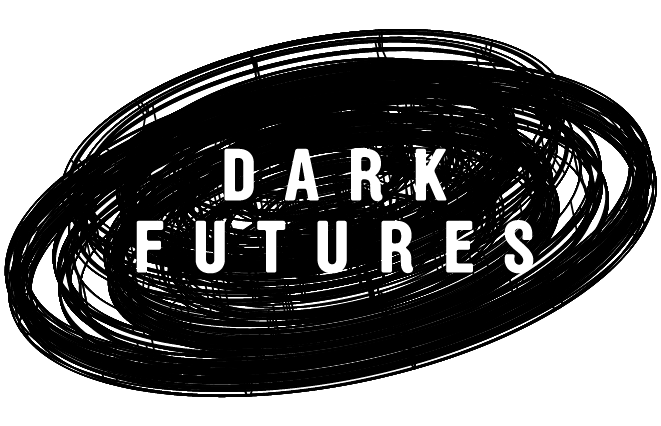
From TV to books to movies, dystopian tales are in the air right now. All week long, Vulture is exploring how theyÔÇÖve been imagined in popular culture.
Even if you agree that humanity has entered dire straits as of late, the fact stands that things could be a lot worse. Year after year, pop culture has predicted the human raceÔÇÖs enslavement, decimation, or complete annihilation at specific moments in time, only to blow deadline after deadline. By mere virtue of not having already reduced the planet to cinders or submitting to a global fascist dictatorship, weÔÇÖve proven a solid handful of apocalyptic movies wrong. The pastÔÇÖs future is destined to become the presentÔÇÖs past, and plenty of visions for apocalypses in a distant tomorrow have come and gone without a peep. Below, weÔÇÖve compiled a timeline of all the dystopias that humankind has successfully skirted in the past 25 years. Just think of it this way: Despite it all, humanity still managed to exceed HollywoodÔÇÖs grim expectations.
1994
The movie: The Apple
The plot: No description can fully capture the lunacy of this disco-infused, sci-fi riff on A Star Is Born. It must simply be seen to be believed. In 1980, director-writer Menahem Golan imagined the far-off world of 1994 under totalitarian rule by the nefarious BIM Corporation, a sinister record label with executives that make Berry Gordy look like Mr. Rogers. Every day, citizens (their foreheads bedecked with a shiny triangular sticker known as a BIM mark) unite in a synchronized dance aired on a nationalist TV program called The BIM Hour. As harshly oppressive societies founded upon obedience go, this oneÔÇÖs definitely got the flashiest dance moves.
1995
The movie: T2: Judgment Day
The plot: The first film in James CameronÔÇÖs killer-robot franchise split its time between its present of 1984 (an ominous year if ever there was one) and the dystopian, android-dominated 2029. WeÔÇÖve still got 12 years to synthesize our own exterminators from steel and laser eyeballs, but the filmÔÇÖs sequel jumped ahead four short years to pit Terminator against Terminator in its vision of the mid-ÔÇÿ90s. Things have not yet completely gone to crap in CameronÔÇÖs hypercharged cat-and-mouse game, but John ConnorÔÇÖs crucial future hangs over each and every scene. Better still, the tangled timelines of this seriesÔÇÖs criss-crossing installments turned the catchphrase ÔÇ£IÔÇÖll be backÔÇØ into a paradoxical, self-fulfilling prophecy.
1996
The movie: 12 Monkeys
The plot: In this remix of Chris MarkerÔÇÖs experimental landmark La Jet├®e, director Terry Gilliam set mankindÔÇÖs demise at one year after his filmÔÇÖs release, loosing a lethal virus on the planet in 1996 before jumping ahead to 2035 to check in with a scraggly colony of survivors, including a time-hopping Bruce Willis. This twisty thriller toys with the idea of rewritable pasts and salvageable futures, culminating in a closed loop that suggests some things in life might be inevitable, even in a world with time travel. ItÔÇÖs not often that Gilliam allows his films a happy ending, and the conclusion of this cult object of worship hits a bittersweet note ÔÇö but by the time the credits roll, their future is secure.
1997
The movie: Escape From New York
The plot: In John CarpenterÔÇÖs gonzo action classic, an epidemic of crime has spread across the United States, peaking at a 400 percent increase in violent incidents. With the nationÔÇÖs jail cells overwhelmed, the U.S. government sees no recourse but to turn Manhattan into AmericaÔÇÖs penal colony, sequestering criminals on the island and cutting it off from the rest of the country. Snake Plissken (an eye-patch-clad Kurt Russell) is tasked with locating the president after Air Force One crash lands on the former metropolis, and safely escorting him out of the island-wide prison. At once an acidic prediction of a prison-industrial complex gone wild and a generously entertaining get-out-alive thriller, itÔÇÖs a pop-culture sucker punch that leaves a lasting bruise.
1999
The movie: Omega Cop
The plot: Sci-fi doesnÔÇÖt get much cheesier than this humbly budgeted fantasy of machismo and Adam West cameos. Producer and world-renowned martial-arts expert Ron Marchini starred as John Travis, the last honest officer of the law in a world ravaged by overheating due to solar-flare radiation. Director Paul Kyriazi split the difference between natural and man-made ruin, drying the Earth to a sunbaked crisp, then showing the desperate lows that humanity would sink to in order to survive. This subÔÇôMad Max hellscape comes complete with corrupt cardboard-cutout governments, roving sex-slave auctions, and violent bands of nomadic marauders, stripping anyone unfortunate enough to cross their paths of all possessions. The resulting vision of 1999 is much less appealing than PrinceÔÇÖs version.
2000
The movie: Death Race 2000
The plot: Paul BartelÔÇÖs 1975 carsploitation picture assumed human nature would have gotten pretty nasty by the new millennium. In this warped version of America, the most popular form of entertainment is a live-broadcast race in which competitors earn points by mowing down children, the elderly, and the disabled. A boldfaced satire on American appetites for sadistic amusement, the film charmed audiences with the guileless weirdness it brought to its cruddy vision of cultural dissolution. To wit: Major characters include Sylvester Stallone as an Al Pacino-themed racer, and a S&M-ish masked victor named Frankenstein.
2005 to 2008
The movie: Southland Tales
The plot: The End (with a capital E ÔÇö a true biblical end, a slouching-toward-Bethlehem end) is nigh in 2005, when nuclear bombs explode over Abilene and El Paso, Texas. Director Richard Kelly then skips ahead a few years into a quagmire characterized by hysteria and extremism, a Bush-era satire thatÔÇÖs grown to seem more fearsomely prescient in the aftermath of the 2016 election. Gaudy, branded TV campaigns sell the American public on new wars and suspect energy sources; an absolute surveillance state enables snipers to pick off dissidents from secluded perches; and the next president of the United States is an amnesiac played by the Dwayne ÔÇ£The RockÔÇØ Johnson. At this point, itÔÇÖs only a matter of time until a high-ranking cabinet member in our own timeline says, ÔÇ£Teen horniness is not a crimeÔÇØ on a hot mic.
2011
The movie: Aeon Flux
The plot: This stylized, futuro-espionage oddity from Karyn Kusama plays out in a walled-in city-state during the year 2415, but weÔÇÖre duly informed that it was back in 2011 when a pathogenic virus first rendered the Earth uninhabitable and reduced mankind to a handful of remainders ruled by a cabal of scientists. The specific effects of the virus play a key role in the gnarled mystery that the title character (Charlize Theron) unravels, and radically reorient her understanding of how the apocalypse transpired. Best of all, the dystopian business takes a hard metaphorical pivot near the third act into a parable about the power of womanhood.
2012
The movies: 2012, I Am Legend
The plots: Two gargantuan blockbusters staked out 2012 as the site of massively scaled calamity. Taking cues from the Mayan calendars nobody actually knows how to read, in 2012 Roland Emmerich imagined a great cataclysm ridding the Earth of its human inhabitants, with tidal waves leveling cities and swarms of tornadoes whipping helicopters around like whirligigs. Meanwhile, the Will Smith vehicle I Am Legend subjected homo sapiens to another supervirus, killing 95 percent of the population and turning most of the stragglers into bloodthirsty hell-monsters. TheyÔÇÖre a study in contrasts: Emmerich seemingly wants to scream the world into oblivion, throwing as much digitally rendered sound and fury at Mother Earth as possible, whereas I Am Legend director Francis Lawrence allows plenty of wide-open spaces, during which Smith can contemplate what has become of his precious society.
2013
The movie: The Postman
The plot: Kevin Costner produced, directed, and starred as the chosen savior of the known world in this sparse 1997 adventure film. CostnerÔÇÖs nameless drifter wanders a barren wasteland 15 years after an unspecified global event eradicated all technology, leaving an Earth strewn with reminders of the world that once was. One such artifact is a postal workerÔÇÖs truck, where Costner dons a mail carrierÔÇÖs uniform and inadvertently ignites a movement that returns hope to a desolated world. The reinstatement of snail mail turns out to be the catalyst for a sweeping revolution, and a heartening reminder that a society which has been dashed is never fully beyond restoration.
2017
The movie: The Running Man
The plot: This Stephen King adaptation sees the U.S. crippled by an economic downturn, then responding by placing trust in an authoritarian state obsessed with censoring public culture. The product of those poor choices? A state-sponsored reality program in which ruthless hunters stalk and kill criminals (such as Arnold Schwarzenegger, playing a wrongly convicted pilot) for sport and public placation. Another perspective on the unseemly American hunger for on-screen violence, rendered with just about as much subtlety ÔÇö but at least this oneÔÇÖs got Ahnuld on a killing spree.


